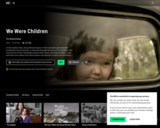
Includes:
-origin of orange shirt day
-suggested videos
-activities
-whole school activities
-suggested stories
+ more!
- Subject:
- Arts Education
- English Language Arts
- Social Studies
- Material Type:
- Activity/Lab
- Author:
- Jean Moir
- Date Added:
- 02/14/2024

This collection of resources can be used to support Orange Shirt Day in your classroom and school.
Be sure to also look at our Reconciliation Collection and Indigenous Perspectives for more resources.

Includes:
-origin of orange shirt day
-suggested videos
-activities
-whole school activities
-suggested stories
+ more!

Level 1 - Grade 5+
Learning Outcomes: • I can articulate the purpose of Orange Shirt Day, and how symbols and testimony work to encourage social change. • I can articulate the history of residential schools in Canada and the ongoing intergenerational impact on Indigenous communities.
Essential Questions: • What does Orange Shirt Day symbolize? • What is the Truth and Reconciliation Commission? • What is the work of reconciliation, and what does it mean to you?

5 Films...
"Orange Shirt Day was launched in 2013 to call attention to 165 years of residential school experiences (1831-1996). For residential school survivor Phyllis Webstad, the severing of the threads connecting her to family, community, and culture began in 1973, when the beautiful orange shirt she wore to her first day of school was stripped from her and never seen again. The removal of the orange shirt was the first of a series of destructive methods enforced to deplete her sense of self-worth, erase her culture, and suppress her spirit. Her story is just one of the experiences described by countless survivors, but many others did not live to tell their own story. Intergenerational experiences rooted in the trauma inflicted through residential schools and other forced-assimilation policies continue to ripple through communities today...."

Orange Shirt Day activities for K-Grade 3This activity pack is ready to use in any primary classroom and ideal to use with children from Grade 1 up to Grade 3 to support important conversations around Orange Shirt Day. It includes a PowerPoint, fact files, art activities and more!

Missing children and the existence of unmarked burial sites at Residential Schools across Canada have been well-known for decades among Indigenous communities. However, Canadians are still grappling with the truths about Residential Schools, spurring long-overdue conversations inside and outside the classroom.
Remembering the Children, the National Centre for Truth and Reconciliation’s publication for students, offers a way to begin those conversations. It takes readers to a variety of Residential Schools across time and space, opening a door into a past that reverberates today, while also celebrating the resilience and resurgence of First Nations, Inuit and Métis peoples’ culture.

The publication Remembering the Children and this complementary educator’s guide
were designed to help students achieve the following goals:
• gain a more complex understanding of the history and reality of residential schools in Canada, recognizing that children who attended Residential
Schools, day schools, industrial schools and boarding schools had their own
unique experiences and that these experiences varied across the country and
across time
• gain an appreciation for Indigenous knowledge and the diversity of traditional
cultures, languages and teachings of First Nations, Inuit and Métis communities
• understand the depth of loss that occurred as a result of the Residential
School system
• learn about contemporary people and organizations who are engaged in cultural revitalization efforts
• understand that they have an individual and collective role in reconciliation
Students and teachers all over Canada will be at different stages of learning. We hope
that the Remembering the Children publication and educator’s guide provide you
with content, resources, voices and ideas so that you can continue these important
conversations all year long.
With appreciation to all educators who are taking on this important work

This resource examines:
*The purpose of residential schools
*The assaults and their legacy
*Resistance and change
*Action for reconciliation
*Case studies
*Resources

This resource examines:
*Setting the stage for inquiry
*150 Years' relationship
*Research
*Resources

This resource examines:
*Learning and relationship with the land
*What were Indian residential schools?
*The Indian residential school experience
*The healing journey
*Resources

This impactful work is based on the Life Story of Elder Mary Courchene during her time in Residential Schools that channels her story of truth, resistance, healing and the reclamation of identity, language, culture and community for herself and her family. We are incredibly proud of this work and are excited to share it with everyone.
We see this curriculum as a living document to be used throughout the school year to help students (and staff) better understand the impacts of Residential Schools. The hope is for classrooms to engage in multiple lessons over a period of time, versus the one-day event to honour Orange Shirt Day.
The curriculum is for middle and senior years level but many pieces can be used and adapted for early years. Elder Mary's story is one of resistance, healing and love. Her truth is a gift to all that will both preserve her story and honour her life's work as an educator and elder who has always so generously shared her story so that children, youth and adults can learn truth and walk the path of reconciliation. We recognize how impactful it will be for all schools across Manitoba and Canada, to have a resource such as this one, Resistance on the Giimooch (Giimooch in Anishinaabemowin means in secret).

Welcome to the Teachers’ Resource Guide for Speaking Our Truth: A Journey of Reconciliation by Monique Gray Smith.
The guide follows the book, chapter by chapter, making it easy for teachers and students to dig deeper into the text and make personal connections to the material. Each chapter of the guide features a
summary, essential questions, metaphors for learning, key concepts and vocabulary
and detailed learning activities.
There is bonus material about making art, keeping a journal and doing research. Activities are laid out clearly, with instructions for teachers and for students as they embark together on the journey of reconciliation.

This booklet is written by Spirit Bear as a youth-friendly guide to the Truth and Reconciliation Commission of Canada (TRC) 94 Calls to Action.
In 2008, a group called the Truth and Reconciliation Commission (TRC) was made. Their job was to listen to stories about residential schools and then write the stories down so we can learn from our mistakes. In 2015, the Truth and Reconciliation Commission announced their 94 Calls to Action. These are 94 activities all governments, courts, businesses, schools, and people living in Canada can do to help fix the mistakes of the past and present so that all children – including First Nations, Métis, and Inuit children – can grow up happy, healthy, safe, and proud of who they are.

"Making the Shift" is a monthly newsletter by Natural Curiosity. The September 2022 edition features lots of information and activities related to Truth and Reconciliation.
A few of the Educator Resources include:
- Orange Shirt Day Resources
- National Centre for Truth and Reconciliation Residential School Resources
- Truth & Reconciliation Discussion Guide from Scholastics Canada
- Take Me Outside Indigenous Resources
- Residential School Survivor Stories
- And much more!

This site is full of free (and paid) resources to help teachers and students.You can filter by age, grade, subject, and more.Search everything from back to school, orange shirt day, and subject specific topics to find great resources.

This guide is a teacher resource containing several classroom activities that explore the stories shared in the Voices from Here video series. Download the education guide and use the worksheets

"In this feature film, the profound impact of the Canadian government’s residential school system is conveyed through the eyes of two children who were forced to face hardships beyond their years. As young children, Lyna and Glen were taken from their homes and placed in church-run boarding schools, where they suffered years of physical, sexual and emotional abuse, the effects of which persist in their adult..."
Mature content - please preview and use discretion. If unsure, get principal and parent permission.
Users outside of SK may not be able to see this. Contact your school division to gain access.

In this condensed life history, Wes FineDay, Nehiyaw Knowledge Keeper, discusses his resistance to colonial violence and his lifelong work and extensive knowledge of medicines, oral history, and ceremony.

Inspired by a woven blanket, the Witness Blanket is a large-scale work of art. It contains hundreds of items reclaimed from residential schools, churches, government buildings and traditional and cultural structures from across Canada.
Here, you can explore the items and stories carried by the Witness Blanket. They are accompanied by the voices of Survivors who talk about the experience of being forced into residential schools. Their generous and insightful stories convey the reality of anti-Indigenous racism, colonialism and genocide. They reveal the ongoing harms caused by Canada’s residential school system.